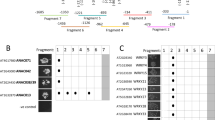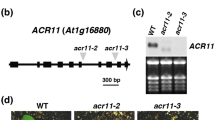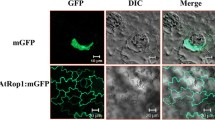Abstract
Mutation in the wound-induced peptide transporter gene AtPTR3 (At5g46050) of Arabidopsis thaliana has been shown to affect germination on media containing a high salt concentration. The heterologous expression in yeast was utilized to verify that the AtPTR3 protein transports di-and tripeptides. The T-DNA insert in the Atptr3-1 mutant in the Arabidopsis ecotype C24 revealed two T-DNA copies, the whole vector sequence, and the gus marker gene inserted in the second intron of the AtPTR3 gene. An almost identical insertion site was found in the Atptr3-2 mutant of the Col-0 ecotype. The AtPTR3 expression was shown to be regulated by several signalling compounds, most clearly by salicylic acid (SA), but also methyl jasmonate (MeJA) and abscisic acid. Real-time PCR experiments suggested that the wound-induction of the AtPTR3 gene was abolished in the SA and JA signalling mutants. The Atptr3 mutant plants had increased susceptibility to virulent pathogenic bacteria Erwinia carotovora subsp. carotovora and Pseudomonas syringae pv. tomato, and produced more reactive oxygen species when grown on media containing paraquat or rose bengal. Public microarray data suggest that the AtPTR3 expression was induced by Pseudomonas elicitors and by avirulent P. syringae pathovars and type III secretion mutants. This was verified experimentally for the hrpA mutant with real-time PCR. These results suggest that AtPTR3 is one of the defence-related genes whose expression is reduced by virulent bacterium by type III dependent fashion. Our results suggest that AtPTR3 protects the plant against biotic and abiotic stresses.








Similar content being viewed by others
Abbreviations
- ABA:
-
Abscisic acid
- coi :
-
Coronatine-insensitive
- Col-0:
-
Columbia-0
- DAB:
-
3,3′-Diaminobenzidine-4 HCl
- fad :
-
Fatty acid desaturase
- Gly:
-
Glycine
- GS:
-
Glucosinolate
- GUS :
-
β-Glucuronidase
- IGS:
-
3-Indolylmethylglucosinolate
- His:
-
Histidine
- JA:
-
Jasmonic acid
- hrp :
-
Hypersensitive response and virulence
- hrc :
-
Hrp concerved
- Leu:
-
Leucine
- Met:
-
Methionine
- MeJA:
-
Methyl jasmonate
- NBT:
-
Nitroblue tetrazolium
- npr :
-
Non-expressor of PR proteins
- Phe:
-
Phenylalanine
- PR:
-
Pathogenesis related
- PTR:
-
Peptide transporter
- ROS:
-
Reactive oxygen species
- SA:
-
Salicylic acid
- SAR:
-
Systemic acquired resistance
- TAIR:
-
The Arabidopsis Information Resource
References
Alonso JM, Stepanova AN, Leisse TJ, et al (2003) Genome-wide insertional mutagenesis of Arabidopsis thaliana. Science 301:653–657
Boccara M, Mills CE, Zeier J, Anzi C, Lamb C, Poole RK, Delledonne M (2005) Flavohaemoglobin HmpX from Erwinia chrysanthemi confers nitrosative stress tolerance and affects the plant hypersensitive reaction by intercepting nitric oxide produced by the host. Plant J 43:226–237
Brader G, Tas É, Palva ET (2001) Jasmonate-dependent induction of indole glucosinolates in Arabidopsis by culture filtrates of the nonspecific pathogen Erwinia carotovora. Plant Physiol 126:849–860
Cao H, Bowling SA, Gordon AS, Dong X (1994) Characterization of an Arabidopsis mutant that is nonresponsive to inducers of systemic acquired resistance. Plant Cell 6:1583–1592
Chiang C-S, Stacey G, Tsay Y-F (2004) Mechanisms and functional properties of two peptide transporters, AtPTR2 and fPTR2. J Biol Chem 279:30150–30157
Craigon DJ, James N, Okyere J, Higgins J, Jotham J, May S (2004) NASCArrays: a repository for microarray data generated by NASC’s transcriptomics service. Nucleic Acids Res 32:D575–D577
De Buck S, de Wilde C, Van Montagu M, Depicker A (2000) T-DNA vector backbone sequences are frequently integrated into the genome of transgenic plants obtained by Agrobacterium-mediated transformation. Mol Breed 6:459–468
Delaney TP, Uknes S, Vernooij B, Friedrich L, Weymann K, Negrotto D, Gaffney T, Gur-Rella M, Kessmann H, Ward E, Ryals J (1994) A central role of salicylic acid in plant disease resistance. Science 266:1247–1250
Delledonne M (2005) NO news is good news for plants. Curr Opin Plant Biol 8:390–396
De Vos M, Van Oosten VR, Van Poecke RMP, Van Pelt JA, Pozo MJ, Mueller MJ, Buchala AJ, Métraux J-P, Van Loon LC, Dicke M, Pieterse CMJ (2005) Signal signature and transcriptome changes of Arabidopsis during pathogen and insect attack. Mol Plant Microbe Interact 18:923–937
Dietrich D, Hammes U, Thor K, Suter-Grotemeyer M, Flückiger R, Slusarenko AJ, Ward JM, Rentsch D (2004) AtPTR1, a plasma membrane peptide transporter expressed during seed germination and in vascular tissue of Arabidopsis. Plant J 40:488–499
Dong X (2004) NPR1, all things considered. Curr Opin Plant Biol 7:547–552
Durrant WE, Dong X (2004) Systemic acquired resistance. Annu Rev Phytopathol 42:185–209
Feys BJF, Benedetti CE, Penfold CN, Turner JG (1994) Arabidopsis mutants selected for resistance to the phytotoxin coronatine are male sterile, insensitive to methyl jasmonate and resistant to a bacterial pathogen. Plant Cell 6:751–759
Fobert PR, Després C (2005) Redox control of systemic acquired resistance. Curr Opin Plant Biol 8:378–382
Forsbach A, Schubert D, Lechtenberg B, Gils M, Schmidt R (2003) A comprehensive characterization of single-copy T-DNA insertions in the Arabidopsis thaliana genome. Plant Mol Biol 52:161–176
Gietz RD, Schiestl RH (1995) Transforming yeast with DNA. Methods Mol Cell Biol 5:255–269
Glawischnig E, Hansen BG, Olsen CE, Halkier BA (2004) Camalexin is synthesized from indole-3-acetaldoxime, a key branching point between primary and secondary metabolism in Arabidopsis. Proc Natl Acad Sci USA 101:8245–8250
Glazebrook J (2005) Contrasting mechanisms of defense against biotrophic and necrotrophic pathogens. Annu Rev Phytopathol 43:205–227
Hammerschmidt R, Tsuji J, Zook M, Somerville SA (1993) A phytoalexin from Arabidopsis thaliana and its relationship to other phytoalexins of crucifers. In: Davis KR, Hammerschmidt R (eds) Arabidopsis thaliana as a model for plant-pathogen interactions. APS Press, St Paul, pp 73–84
Hansen BG, Halkier BA (2005) New insight into the biosynthesis and regulation of indole compounds in Arabidopsis thaliana. Planta 221:603–606
Karim S, Lundh D, Holmström K-O, Mandal A, Pirhonen M (2005) Structural and functional characterization of AtPTR3, a stress-induced peptide transporter of Arabidopsis. J Mol Model 11:226–236
Kariola T, Palomäki TA, Brader G, Palva ET (2003) Erwinia carotovora subsp. carotovora and Erwinia-derived elicitors HrpN and PehA trigger distinct but interacting defense responses and cell death in Arabidopsis. Mol Plant Microbe Interact 16:179–187
Kariola T, Brader G, Li J, Palva ET (2005) Chlorophyllase 1, a damage control enzyme, affects the balance between defense pathways in plants. Plant Cell 17:282–294
Kim MG, da Cunha L, McFall AJ, Belkhadir Y, DebRoy S, Dangl JL, Mackey D (2005) Two Pseudomonas syringae type III effectors inhibit RIN4-regulated basal defense in Arabidopsis. Cell 121:749–759
Kliebenstein DJ (2004) Secondary metabolites and plant/environment interactions: a view through Arabidopsis thaliana tinged glasses. Plant Cell Environ 27:675–684
Koh S, Wiles AM, Sharp JS, Naider FR, Becker JM, Stacey G (2002) An oligopeptide transporter gene family in Arabidopsis. Plant Physiol 128:21–29
Mandal A, Sandgren M, Holmström K-O, Gallois P, Palva ET (1995) Idendification of Arabidopsis thaliana sequences responsive to low temperature and abscisic acid by T-DNA tagging and in-vivo gene fusion. Plant Mol Biol Rep 13:243–254
Mattinen L, Tshuikina M, Mäe A, Pirhonen M (2004) Identification and characterization of Nip, necrosis-inducing virulence protein of Erwinia carotovora subsp. carotovora. Mol Plant Microbe Interact 17:1366–1375
McConn M, Browse J (1996) The critical requirement for linolenic acid is pollen development, not photosynthesis, in an Arabidopsis mutant. Plant Cell 8:403–416
Mou Z, Fan W, Dong X (2003) Inducers of plant systemic acquired resistance regulate NPR1 function through redox changes. Cell 113:935–944
Murashige T, Skoog F (1962) A revised medium for rapid growth and bioassays with tobacco tissue culture. Physiol Plant 15:473–497
Mysore SK, Ryu CM (2004) Non-host resistance: how much do we know? Trends Plant Sci 9:97–104
Nomura K, Melotto M, He S-Y (2005) Suppression of host defense in compatible plant-Pseudomonas syringae interactions. Curr Opin Plant Biol 8:361–368
Norman-Setterblad, Vidal S, Palva ET (2000) Interacting signal pathways control defense gene expression in Arabidopsis in response to cell wall-degrading enzymes from Erwinia carotovora. Mol Plant Microb Interact 13:430–438
Nürnberger T, Brunner F, Kemmerling B, Piater L (2004) Innate immunity in plants and animals: striking similarities and obvious differences. Immunol Rev 198:249–266
Penaloza-Vazquez A, Preston GM, Collmer A, Bender CL (2000) Regulatory interactions between the Hrp type III protein secretion system and coronatine biosynthesis in Pseudomonas syringae pv. tomato DC3000. Microbiology 146:2447–2456
Redman JC, Haas BJ, Tanimoto G, Town CD (2004) Development and evaluation of an Arabidopsis whole genome Affymetrix probe array. Plant J 38:545–561
Saier MH Jr (2000) Families of transmembrane transporters selective for amino acids and their derivatives. Microbiology 146:1775–1795
Schenk PM, Kazan K, Wilson I, Anderson JP, Richmond T, Somerville SC, Manners JM (2000) Coordinated plant defense responses in Arabidopsis revealed by microarray analysis. Proc Natl Acad Sci USA 97:11655–11660
Schilmiller AL, Howe GA (2005) Systemic signaling in the wound response. Curr Opin Plant Biol 8:369–377
Song W, Steiner H-Y, Zang L, Naider F, Stacey G, Becker JM (1996) Cloning of a second Arabidopsis peptide transport gene. Plant Physiol 110:171–178
Song W, Koh S, Czako M, Marton L, Drenkard E, Becker JM, Stacey G (1997) Antisense expression of the peptide transport gene AtPTR2-B delays flowering and arrests seed development in transgenic Arabidopsis plants. Plant Physiol 114:927–935
Stacey MG, Koh S, Becker J, Stacey G (2002a) AtOPT3, a member of the oligopeptide transporter family, is essential for embryo development in Arabidopsis. Plant Cell 14:2799–2811
Stacey G, Koh S, Granger C, Becker JM (2002b) Peptide transport in plants. Trends Plant Sci 7:257–263
Stangeland B, Nestestog R, Grini PE, Skrbo N, Berg A, Salehian Z, Mandal A, Aalen RB (2005) Molecular analysis of Arabidopsis endosperm and embryo promoter trap lines: reporter-gene expression can result from T-DNA insertions in antisense orientation, in introns and in intergenic regions, in addition to sense insertion at the 5′ end of genes. J Exp Bot 56:2495–2505
Szabados L, Kovács I, Oberschall A, Ábrahám E, Kerekes I, Zsigmond L, Nagy R, Alvarado M, Krasovskaja I, Gál M, Berente A, Rédei GP, Haim AB, Koncz C (2002) Distribution of 1,000 sequenced T-DNA tags in the Arabidopsis genome. Plant J 32:233–242
Tax FE, Vernon DM (2001) T-DNA-associated duplication/translocations in Arabidopsis. Implications for mutant analysis and functional genomics. Plant Physiol 126:1527–1538
Thilmony R, Underwood W, He SY (2006) Genome-wide transcriptional analysis of the Arabidopsis thaliana interaction with the plant pathogen Pseudomonas syringae pv. tomato DC3000 and the human pathogen Escherichia coli O157:H7. Plant J 46:34–53
Thomma BPHJ, Nelissen I, Eggermont K, Broekart WF (1999) Deficiency in phytoalexin production causes enhanced susceptibility of Arabidopsis thaliana to the fungus Alternaria brassicicola. Plant J 19:163–171
Tierens KFM-J, Thomma BPHJ, Brower M, Schmidt J, Kistner K, Porzel A, Mauch-Mani B, Cammue BPA, Broekaert WF (2001) Study of the role of antimicrobial glucosinolate-derived isothiocyanates in resistance of Arabidopsis to microbial pathogens. Plant Physiol 125:1688–1699
Truman W, de Zabala MT, Grant M (2006) Type III effectors orchestrate a complex interplay between transcriptional networks to modify basal defence responses during pathogenesis and resistance. Plant J 46:14–33
van Wees SCM, de Swart EAM, van Pelt JA, van Loon LC, Pieterse CMJ (2000) Enhancement of induced disease resistance by simultaneous activation of salicylate- and jasmonate-dependent defense pathways in Arabidopsis thaliana. Proc Natl Acad Sci USA 97:8711–8716
Velikova V, Edreva A, Loreto F (2004) Endogenous isoprene protects Phragmites australis leaves against singlet oxygen. Physiol Plant 122:219–225
Vicente JAF, Peixoto F, Lopes ML, Madeira VMC (2001) Differential sensitivities of plant and animal mitochondria to the herbicide paraquat. J Biochem Mol Toxicol 15:322–330
Vidal S, Eriksson ARB, Montesano M, Denecke J, Palva ET (1998) Cell wall-degrading enzymes from Erwinia carotovora cooperate in the salicylic acid-independent induction of a plant defense response. Mol Plant Microbe Interact 11:23–32
Weiler EW, Kutchan TM, Gorba T, Brodschelm W, Niesel U, Bublitz F (1994) The Pseudomonas phytotoxin coronatine mimics octadecanoid signalling molecules of higher plants. FEBS Lett 345:9–13
Wittstock U, Halkier BA (2002) Glucosinolate research in the Arabidopsis era. Trends Plant Sci 7:263–270
Wohlgemuth H, Mittelstrass K, Kschieschan S, Bender J, Weigel H-J, Overmyer K, Kangasjärvi J, Sandermann H, Langebartels C (2002) Activation of an oxidative burst is a general feature of sensitive plants exposed to the air pollutant ozone. Plant Cell Environ 25:717–726
Zeidler D, Zähringer U, Gerber I, Dubery I, Hartung T, Bors W, Hutzler P, Durner J (2004) Innate immunity in Arabidopsis thaliana: lipopolysaccharides activate nitric oxide synthase (NOS) and induce defense genes. Proc Natl Acad Sci USA 101:15811–15816
Zimmermann P, Hirsch-Hoffmann M, Hennig L, Gruissem W (2004) GENEVESTIGATOR. Arabidopsis microarray database and analysis toolbox. Plant Physiol 136:2621–2632
Zook M, Hammerschmidt R (1997) Origin of the thiazole ring of camalexin, a phytoalexin from Arabidopsis thaliana. Plant Physiol 113:463–468
Acknowledgments
We thank the Arabidopsis Biological Resource Center (Ohio State University, Columbus, OH, USA) for biological material, J.G. Turner (University of East Anglia, Norwich, UK) for coi1 seeds, J. Ryals (Paradigm Genetics, Research Triangle Park, NC, USA) for NahG seeds, J.A. Browse (Washington State University, Pullman, WA, USA) for the triple fad seeds and Elina Roine (University of Helsinki, Finland) for the hrpA and hrcC mutant strains. Linda Strömbom and Neven Zoric at TATAA Biocenter (http://www.tataa.com) are thanked for help with the real-time PCR assays.
Author information
Authors and Affiliations
Corresponding author
Rights and permissions
About this article
Cite this article
Karim, S., Holmström, KO., Mandal, A. et al. AtPTR3, a wound-induced peptide transporter needed for defence against virulent bacterial pathogens in Arabidopsis . Planta 225, 1431–1445 (2007). https://doi.org/10.1007/s00425-006-0451-5
Received:
Accepted:
Published:
Issue Date:
DOI: https://doi.org/10.1007/s00425-006-0451-5




